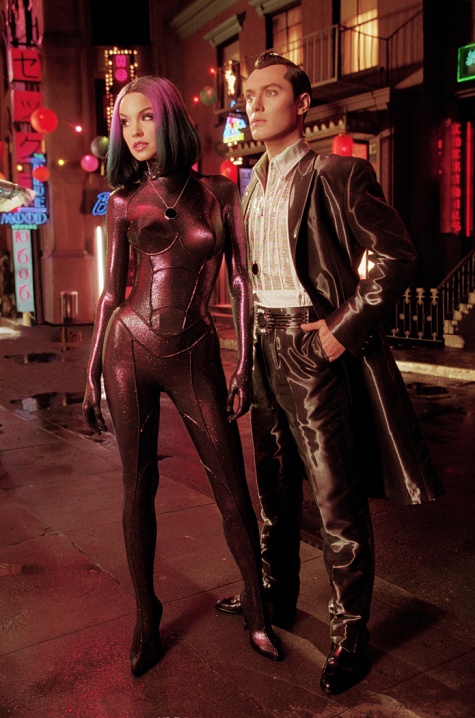
Sex Week: Alone Together (in Bed)
Written by: Anastasia Salter, Pop-Culture Editor
 Ever since Trekkie Monster sung “The Internet is for Porn” in Avenue Q, the primary role of the ‘net has been clearly established in pop culture. But for all the images and videos that make Google’s safe search a workplace necessity technology is still catching up with the imagined future of sex that science fiction has already begun to explore with some fascinating notions of techno-sex to come. (Some videos NSFW)
Ever since Trekkie Monster sung “The Internet is for Porn” in Avenue Q, the primary role of the ‘net has been clearly established in pop culture. But for all the images and videos that make Google’s safe search a workplace necessity technology is still catching up with the imagined future of sex that science fiction has already begun to explore with some fascinating notions of techno-sex to come. (Some videos NSFW)
Let’s start with the basics: the Internet may be for porn, but in science fiction, pornography is already better. For one thing, two-dimensions won’t cut it anymore. Check out the dancing hologirl in the absurd cult classic Earth Girls are Easy (the hologirl is about 1:50 in). She may be an early prototype of what to come and what, indeed, is already here. Japan has a 3D hologram rock star who is already selling out concerts.
Trekkie Monster’s anthem is all about software, but the revolution in sci-fi is heavy on hardware. It’s no secret that in the era of Apple hardware is getting sexier. The lighting in Verizon’s iPhone commercial reminds us that we’re looking at a fetish object: the darkness accentuates the curves and every image telegraphs the desirability of the device. Is it so far of a leap, then, from there to androids that are fully functional?
Just ask the original “anatomically correct android.” Oh, and beware–the filk that accompanies this video might leave lasting mental trauma:
Data was just one stop on the show that promised to boldly go where no man had gone before. Sure, Star Trek was all about the aliens. Many aspired to follow in Kirk’s footsteps, as Jay contemplated in Clerks II: “Like, be the first motherfucker to see a new galaxy, or find a new alien lifeform… and fuck it. And people’d be like, ‘There he goes. Homeboy fucked a Martian once.'” We’re no closer to aliens, but the hardware for a “single-function” versions of Data is coming along.
While aliens remain regular fixtures in the Star Trek universe, the addition of androids and Borgs opened more avenues to explore the dehumanizing of love and sex. The theme continued with Seven of Nine, who took her lesson on “Love amid the stars” from the Doctor. Like Data, she was fully functional, but approached the matter with android logic.
The android approach is all logic and reason. Sex is completely the opposite: as a scene from The Matrix highlights, in orgasm “Soon the why and the reason are gone, and all that matters is the feeling itself.” This scene is particularly admirable for the virtualization of passion–as nothing in The Matrix is real, everything comes down to the triggering of neurons, the relationship of impulses that can in fact be entirely removed from the physical sensation.
Of course, Data isn’t an example of dedicated hardware–maybe that’s why he can’t quite connect to the world of love and sex. For that, AI’s Gigolo Joe offers a vision of the future where hardware hasn’t just achieved functionality–it’s one-upped the original. As Joe himself explains, “We are the guiltless pleasures of the lonely human being. You won’t get us pregnant or have us to supper with mommy and daddy. We work under you, we work on you and we work for you. Man made us better at what we do than was ever humanly possible.”
Sherry Turkle’s recent book, Alone Together: Why We Expect More From Technology and Less from Each Other, considers the reality of robots as replacements for companionship in a number of situations (and all that could entail). In an interview with Stephen Colbert, Turkle pointed out how many technologies that offer connectiveness can make us even more alone.
Future sex often shows the same collective fear that technology will replace us even in the most physical sense. After all: if Gigolo Joe is really “better at what we do that was ever humanly possible,” what’s left for man?
In the technology-driven future imagined by Demolition Man, “fluid transfer” is no longer in vogue. The act of sex is entirely conducted through VR helmets at a physical distance of several feet. 20th century holdover Spartan rejects the notion that this is in fact sex–and, indeed, it’s hard tosee this as a pathway to greater intimacy.
Virtual reality sex is even weirder in Lawnmower Man The future imagined by Lawnmower Man explores the idea that in a space governed by imagination anything would be possible, including things that would be better left unrealized. The technology of it — bodysuits, gloves, helmets – is all in progress. VR encounters in upscale arcades or DisneyQuest have better graphics even if they lack in a full-body experience. But as the 90s computer graphics convey a decidedly unsexy future for intercourse, let’s hope there’s something better around the corner.
This scene is no weirder than anything you could stumble upon in Second Life now. Like Second Life, these are substitutes for the “real thing”, imagined ways to escape the limits of the physical body by replacing it with hardware or abandoning it entirely. Our own technology is catching up with science fiction–in and out of bed.
